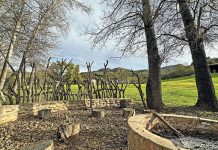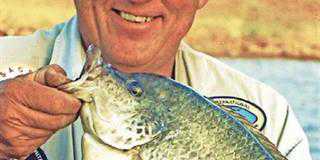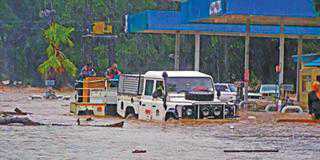As we approached the discarded wooden door in the long grass where someone had illegally dumped a pile of rubble, I knew there had to be a snake underneath.
After all, this area near Swartkops Airforce Base, south of Pretoria, was not called Snake Valley for nothing. In our young days Ben van der Waal and I went on regular snake catching excursions, during which it was quite easy to locate snakes under stones, logs, or other objects or simply on the road while driving in rural areas at night.
It was not unusual to open a disused termite mound to find 10 snakes of four different species inside.That’s a thing of the past.
While Ben prepared to pick up the door, I sat down, cross-legged and ready to do the catching, but what happened next was unexpected. As Ben lifted the door, two snakes darted out quickly and came straight at me before I could see what they were.
The one shot past me into the grass, but the other saw a dark hole beside my shoe and dived into it. Unfortunately it was the bottom of my trousers and there was a cul-de-sac at the top. I simply pulled up my trouser-leg, got hold of the snake’s tail and pulled it out. It was a beautiful fork-marked sand or whip snake (Psammophis sibilans trinasalis) and the easiest way I’ve ever caught any of these agile snakes.
Meanwhile, Ben had dropped the door and raced after the one that had escaped. He finally caught up with it and captured it. It was an olive grass snake (Psammophis sibilans sibilans), a cousin of the first one.
As the scientific names implies, they belong to two subspecies of the same grass snake species. I was elated as it was exactly what I was searching for.
This incident happened almost half a century ago and, while it was great fun, the aim of our excursions was to improve our knowledge of snakes and possibly make a small contribution to the science of herpetology.
I knew that those two snakes could be found at Snake Valley, and as zoology students we questioned the fact that they were classified as related subspecies. By finding them under the same door, we couldn’t have proven our point in a more dramatic way.
Although different subspecies can interbreed, they’re supposed to have developed differences over a long period of geographic isolation. If two subspecies, such as blesbok and bontebok co-exist in the same place, interbreeding would soon eradicate any difference between them.
After capture, we proudly took our prize to Wulf Haacke, herpetologist at the Transvaal Museum.
Today they are two separate species. The one I caught is known as the Kalahari sand snake (P. trinasalis) and the other is the short-snouted grass snake (P. brevirostris).
The name P. sibilans is reserved for the much larger olive grass snake often mistaken for a mamba in Zululand and the Eastern Lowveld.
Times are a-changing
Ever since my father bought me my first snake book, Vivian FitzSimons’ original Snakes of Southern Africa when I was at university in 1962, knowledge about our snakes has increased tremendously.
I recently bought Johan Marais’s new snake book with the same title and was amazed. Not only because it’s a superb, comprehensive field-guide, but because the number of known species had increased by a third.
In 1962, a total of 137 snake species had been identified. Marais’s book now lists 180 and a subsequent discussion with him revealed that another seven new species have since been described.
That’s an increase of 50 species in 50 years. Who said the time for nature’s discoveries has past? There used to be only two species of wolf snake. Now there are eight. Garter snake species have increased from five to 10 and sand snakes from nine to 13.
Several new adder species, including two new berg adders, have been recognised, while some that were thought to be different species have now been shown to be the same.
Apart of diligent field work and collecting by present-day herpetologists, the added genetic technology of DNA analysis undoubtedly contributed significantly to this taxonomical advance. But it’s a case of when more is less.
Alarming numbers
This tremendous increase in snake species is quite ironic in the light of my subsequent observation of a serious reduction in the number of snakes. And I’m not alone. It is supported by the first major international study of a mysterious global decline in snakes, published in June 2010.
Scientists in five countries across three continents, including Africa, reported “alarming” declines in snake numbers after monitoring 17 populations in a variety of habitats. Since 1998 they found evidence of major “population crashes” – sudden declines followed by no sign of recovery. Although many of you may not like snakes as much as I do, this is another powerful sign of the worldwide destruction of the natural world.
These scientists proposed that global warming may be the cause, something I reject with contempt. It’s as boring and hackneyed as blaming apartheid for everything that goes wrong nowadays. It’s time we face the facts. The soil, water and atmosphere of most places on earth is so contaminated and polluted by industrial chemicals, pesticides and other man-made toxins that every living thing is affected.
Because of bio-accumulation, smaller predators such as raptors, most reptiles and amphibians suffer the most, but many of us will surely not escape its effect on our health, lifespan and cause of death. Overflowing doctor’s rooms and cancer wards are testimony of this.
Apart from consumer demand for luxury and perfection, industry and mining’s arrogant disregard of future generations’ environmental needs and agriculture’s overemphasis on production at all cost are the main causes for this. GM food production, hundreds of new mines on agricultural land where food is produced, plus the potential for toxic pollution on a mammoth scale from fracking will just exacerbate an already bad situation.
In 2007, Dr Carl Albrecht, head of research at the Cancer Association of South Africa (Cansa) and one of the foremost cancer researchers in the world, warned that the industrial giants suppress the huge role chemicals play in causing cancer, because of the “big money” involved. He repeated it in August this year and added that 90% of cancers are caused by the environment.
This year more than 10 million people in the world are expected to be diagnosed with cancer, which kills more people than Aids, malaria and TB combined.
All the toxins and harmful chemicals in the food we eat, the water we drink and the air we breathe are more dangerous and more likely to kill you and should be feared more than all the snakes in the world.
Contact Abré J Steyn on 083 235 4822 or email [email protected].
Caption:
The southern adder (Bitis armata) – one of the many new snake species in Johan Marais’s excellent book Snakes of Southern Africa. This species was only described in 1997, after it went unnoticed for three centuries around Cape Town, where much of its fynbos habitat has been destroyed.
JOHAN MARAIS













